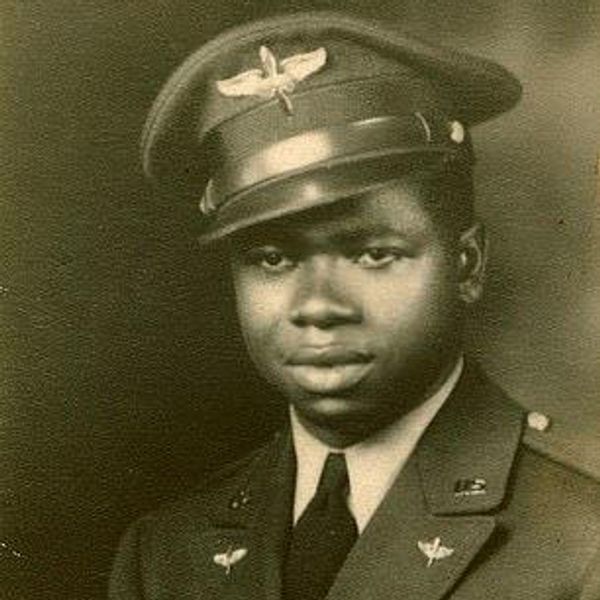You can often catch Scales, a 75-year-old second-generation resident of the neighborhood, sitting on his porch. Walking by, he might let you in for a glass of water while you "sit a spell" and have a conversation.
"Some people laugh about it, whatever, but we strive to keep this neighborhood. Rogers Washington Holy Cross Heights was a fight to get here," Scales said. "We took care of our own and the houses, our parents built what they could with the money they had."

Scales followed in the footsteps of his father and became a pilot. Norman Scales Sr., was a Tuskegee Airman and Austin's first Black fighter pilot. History is important to Scales, which is precisely why he wants to preserve the neighborhood.
Historical designation

The neighborhood, which is located off of Manor Road between Chestnut and Walnut Ave., was designated as a historic district in September 2020, the first in Austin to commemorate the history of a primarily Black neighborhood. The homes of the historic area were featured for the first time in this year's annual Homes Tour, put on by Preservation Austin.
Usually in person but held virtually this year due to the pandemic, the Homes Tour is an annual event that has been showcasing "our community's diverse heritage and incredible neighborhoods every spring" for the past 40 years. Proceeds from the tour benefit advocacy efforts of Preservation Austin.
"East Austin is undergoing, I think the most rapid redevelopment in the city and has been for some time now, and that's where historically our African American and Mexican and Mexican American communities were segregated," said Lindsey Derrington, Preservation Austin executive director. "New development is rapidly taking over neighborhoods, raising property values. We've got these giant homes going up next to post-war houses, raising property values and it's really problematic and it's just causing a lot of folks to move out of East Austin."
Houses in the Rogers Washington Holy Cross historic district were built there by Austin's Black residents during the Jim Crow era, mostly in the late 1950s and early 1960s. Most of the residents have been there for decades and almost all of them know each other.
Integrating in a segregated world
Lavon Marshall grew up in East Austin on Washington Avenue. As an adult, Marshall, her husband and her children moved to Georgia at the beginning of racial integration in 1957 and her children attended an integrated school as first and second graders. Marshall was "promised that we would have no problems" by the school's principal, and outside of a small, resolved incident, her children integrated fairly seamlessly.

It was a different story when Marshall's family returned to Austin to live in her parents' newly built home in 1966. Austin schools were not fully integrated until 1971—17 years after the ruling in Brown v. Board of Education.
"When they started to go to Blackshear Elementary, it was still segregated. They didn't become integrated until they closed Kealing (Middle School) and Anderson (High School)," Marshall said. "(After integration) there were bomb threats for the buses. There were fights. My husband and I spent, I'm sure, a third of our time going to either of the schools to quell threats."

It was the first Black principal of Anderson Hill School and the Marshall family's neighbor, Dr. Charles Akins, who drove their kids to school to their extracurriculars and pushed Black kids to succeed in an integrated school.
After a tough day at school, the kids would go home to being surrounded by friends. "Being in Rogers Washington Holy Cross, you knew you had friends. Everybody knew everybody in the neighborhood," Marshall said.
Preserving Rogers Washington Holy Cross Heights
After growing up and watching the neighborhood change, Scales and Marshall said they find it painful to see "McMansions" popping up and people moving into an area where just 20 years ago, "white people were taught that everything bad happened."
With the new historical designation, developers will have a harder time building in the neighborhood and asking homeowners to sell their homes, due to the "exceptional value" an area has in history. It's welcome news to the neighborhood that doesn't want to see any neighbors forced out.
"I listen to the people who come in here that are more affluent, or make more money than most of us do, and the first thing they want to do is change it, but they don't know the history and what these people went through," Scales said. "It represents something that can't be duplicated."

There is still time to see all of the houses put forth in Preservation Austin's Homes Tour. Ticket sales will reopen for two weeks starting this Thursday until July 8.
"They're not gonna see something that's overly architectural here but you will see that this was a house of a person who served your country, no matter the color of your skin, and it's a place that says, 'look at this house, this is a house where people are welcome, no matter your ethnicity," Scales said.
Read more on Austin neighborhoods:

From Your Site Articles
"center" - Google News
June 24, 2021 at 12:47AM
https://ift.tt/2SZEHnQ
$200M Holdsworth Center opens public educator training campus on Lake Austin - Austonia
"center" - Google News
https://ift.tt/3bUHym8
https://ift.tt/2zR6ugj
Bagikan Berita Ini














0 Response to "$200M Holdsworth Center opens public educator training campus on Lake Austin - Austonia"
Post a Comment